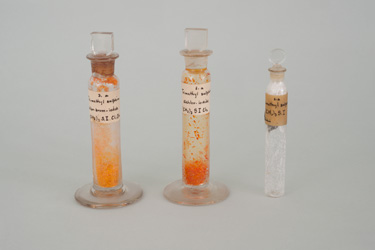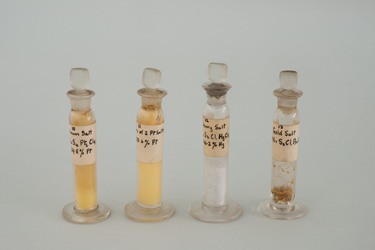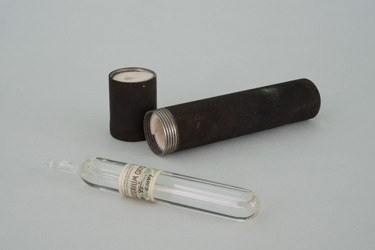Phosphonium, sulphinium and organosulphur compounds, items 147, 152, 153.
Rare earth hydroxides, items 158, 195
These were the products of work by Masson at Edinburgh and later in collaboration with Kirkland in the 1880, investigating the covalency of Phosphorus in Phosphonium compounds, as well as the nature of bonding in alkyl sulphinium compounds.
The rare earth hydroxides are from the work of J.S. Anderson
J.T. Radford “The chemistry department of the University of Melbourne”, 1978, p. 55; Orme Masson and J.B.Kirkland, “Action of Bromine and Chlorine on the salts of Tetraethylphosphonium”, “Preparation of the Salts of Triethyl and Tetraethylphosphonium and Analogous Bases”, J.C.S. (Trans), 1889, 55, 126 and 135.
Heavy Water (D2O) Sample, item 160
We have no information at present about the provenance of this sample. It is possible that it was acquired during the 1930s, when heavy water became a curiosity following the discovery of the neutron (Chadwick, 1932) and the isolation of Deuterium, heavy hydrogen, with an atomic weight of 2, by Urey (1932). Deuterium is a minor proportion of ordinary hydrogen (about 0.002%) and the only source of heavy water in the 1930s was from the Norsk Hydro plant in Ryukan in Southern Norway, where hydrogen was generated from the electrolysis of water, using Norway’s abundant cheap hydroelectric power. This hydrogen was used as feedstock in the synthesis of ammonia for fertilizer by the Haber process. Hydrogen is discharged at the cathode preferentially to deuterium, so that repeated electrolysis and recycling of a sample concentrated the deuterium in the electrolyte.
The Norsk Hydro plant was taken over by the Germans in April 1940 after their invasion of Norway, but not before all stocks of heavy water had been spirited away to France by plane, and then further transferred to Britain during the fall of France in June 1940. The German atomic research effort focused on the use of heavy water as a moderator in their proposed fission reactor, in which slow neutrons reacted with the U235 isotope to produce nuclear fission (fission of 235U by slow neutrons had been discovered in Berlin in 1939 by Hahn and Strassmann, with the assistance in exile in Stockholm of Lise Meitner). The allies succeeded in interrupting the heavy water supply from Norway in 1943 by several commando attacks, both on the Ryukan plant, and on the ferry taking the stocks of D2O to Germany.
The Germans never did succeed in building a working fission reactor, the first requirement of an atomic weapons program. In the USA, the Manhattan project employed graphite as the moderator in the first successful reactor in Chicago in 1942, and went on to make the first atomic bombs in 1945.
For a popular account of the early atomic researchers, see Preston, Diana “Before the Fallout – from Marie Curie to Hiroshima” (2005)




